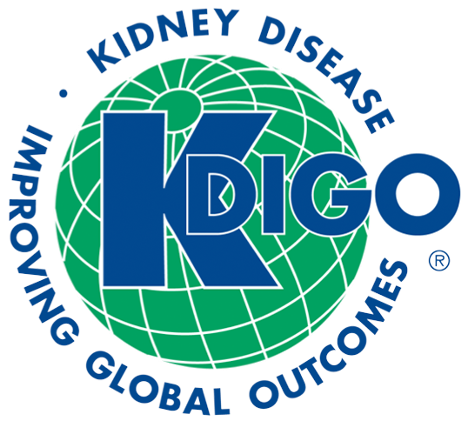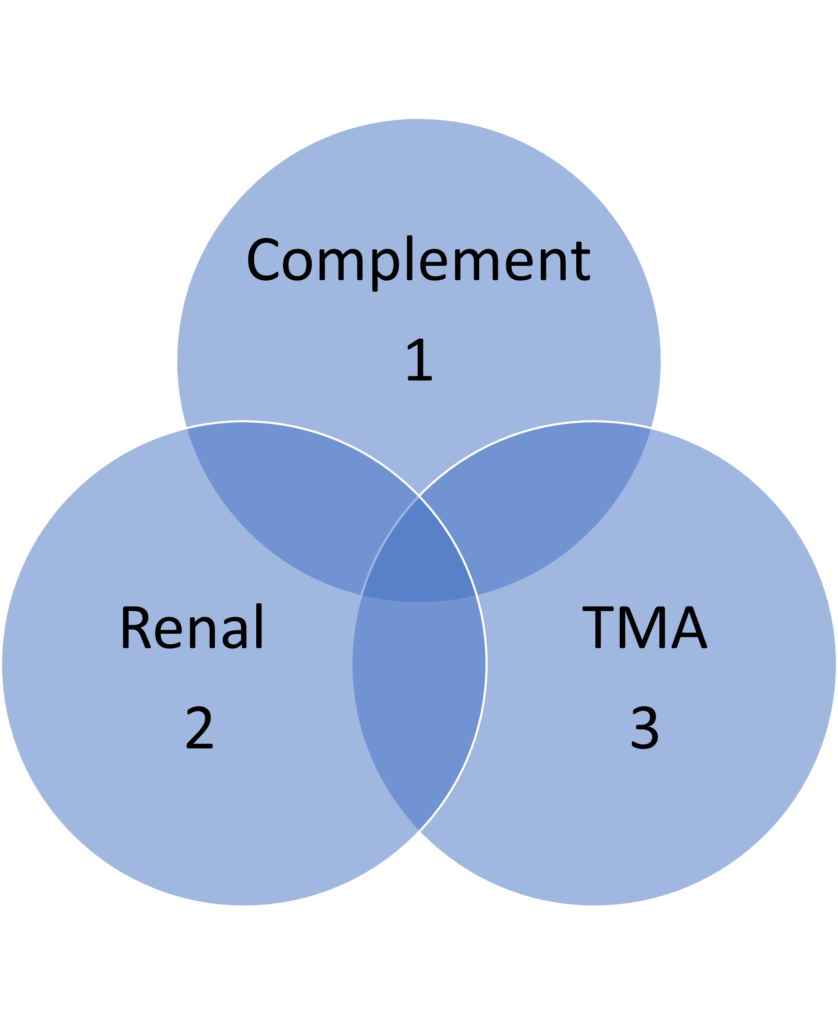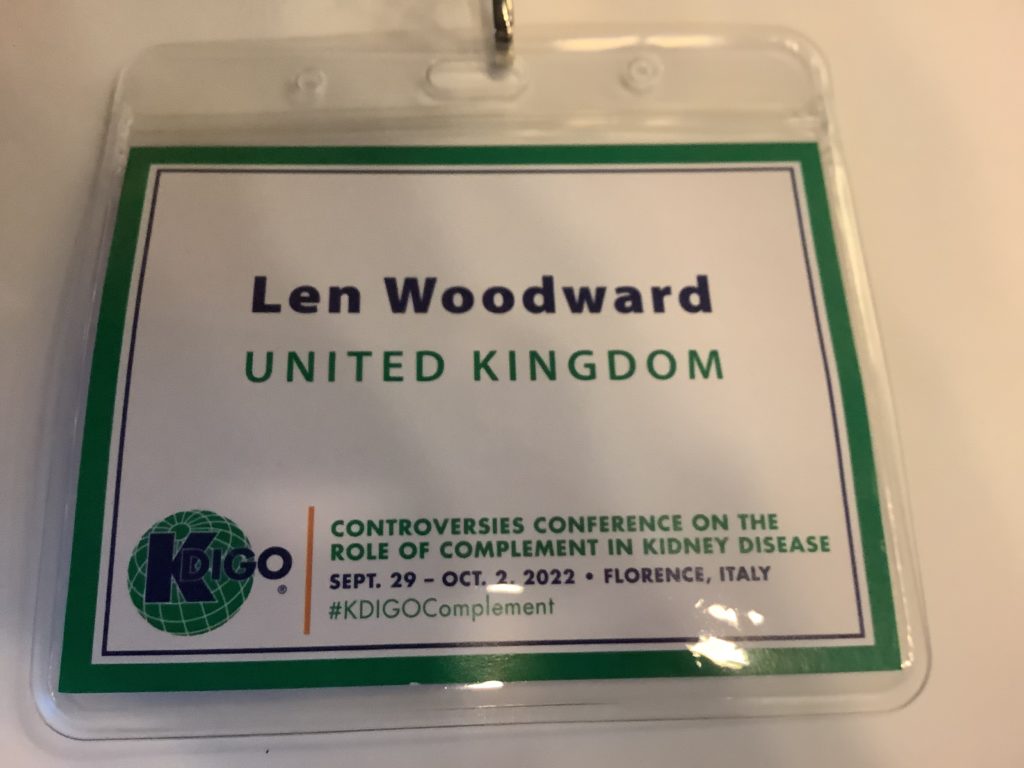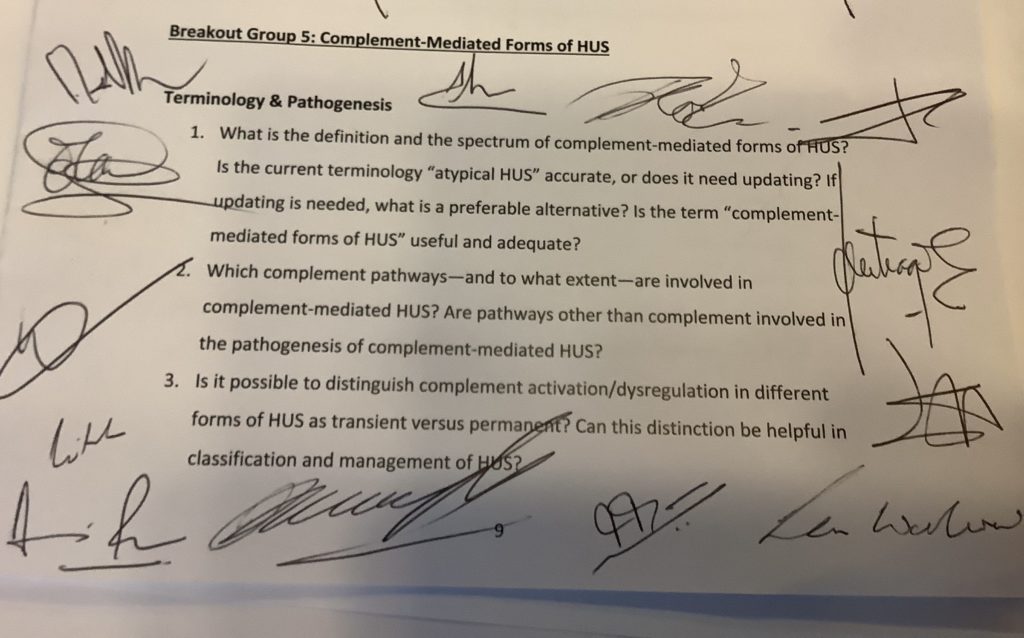As an aHUS advocate you can often be surprised by events. Nearly three months ago I received an e mail inviting me to attend a conference about Complement Renal Disease. I had not asked to attend, and in any case it was by invitation only. But definitely addressed to me. Why me and should I attend?

The invite had come from the organisation Kidney Disease Improving Global Outcomes (KDIGO). Well, I knew aHUS is a complement renal disease and Global Action’s aim is to do things to improve the outcomes for aHUS patients everywhere. So it seemed relevant.
I had not known the conference was planned. The ISN event in Bergamo in June was the key event in 2022 for aHUS as far as I was concerned and now there was another opportunity to learn more about aHUS I thought.
So having accepted the invitation it was just a matter of waiting for more information- the meeting agenda was available on line on the KDIGO website . It was to be a four day conference! Also the roster of all the other participants became available.
The conference was about more than aHUS. There were a whole host of other diseases that were included in its scope. Some I was familiar with, some I had heard of but knew little about, and a few were new to me, There was no mention of aHUS, but I was to join the “Complement Mediated HUS ” group. It was the fifth group of five and I was the patient member for the group.
Over the years, one way or another, as an advocate you get to know clinicians who have an interest in aHUS. So not surprisingly there were several people in the group I had met before. Including one of the co-leaders of the group, Prof. Fadi Fakhouri. I have met him many times and Fadi has featured in this website frequently over the years. Particularly in association with pregnancy and aHUS. There were others I had met before too. The rest of the group are researchers who I do know about from reading their aHUS research articles.
An eminent group of researchers and if I mention one in particular ,Santiago Rodriguez de Cordoba, you get an idea of how expert this group is. ( As always with these meet ups you get the chance to meet people who you have been aware of for a long time . So I got to speak to Santiago about his research article which I featured on our website just weeks ago. It was about whether each complement genetic variant is aHUS disease causing or not ( see HERE).
He was able to explain to me things that I had not understood in the article. And I could test my understanding too, so I was much more confident about my interpretation., Not only that, he then told me about some other research that he had recently completed. It was about what the risks of disease onset were for other family members of an aHUS patient . He had found that it was less likely than was previously thought. Of course that will now be the subject of a future website article.
But I digress.

I was to be the patient representative for the complement renal TMAs group of patients ( i.e. the patients at the centre of the above image, which would include aHUS patients) and that providing their patient voice would be my job. it has been noticeable how, over the years, such meetings are now increasingly including patients too, to add a patient centricity. KDIGO has a long history of doing so in their conferences. Global Action’s Linda Burke attended the last aHUS KDIGO conference in 2015.
There were also other patient representatives in the other four groups. Eight of us altogether. And according to the agenda all eight of us were to talk about what matters to patients within our respective diseases on the first morning of the conference. We had 30 minutes to share between the eight of us. We got to meet before the conference via that ubiquitous zoom platform these days. We were briefed on what was expected from us. So some pre-meeting work to do to use the four minutes or so allotted to me to raise what matters to aHUS patients.
There was also a pre-meeting for the “breakout group” as we were called. Firstly to be briefed on the conference format ,i.e. a “controversy” conference, was to be conducted. The TMA’s group task was to answer 11 topics of controversy for complement mediated forms of HUS. This was to be done in two half day breakout sessions. Then following each session the group would go back to the main group and present what we had agreed on and what we had not. Importantly also, what further research was needed.
Before the meeting we were split into three sub-groups and each sub-group was to provide the initial slides to talk about. So a little more pre-work to do.
Then, sooner than you think, the day arrived for the start of meeting. I traveled by air, my first flight since before the start of COVID. I have so far avoided catching COVID, so it was a concern. The conference was being held in the outskirts of Florence,Italy but my flight was to Pisa so I got to see and confirm that its tower does lean a bit, before getting the train to Florence.
I got there in time to join an evening reception and a chance to “mingle” with other participants , many of whom were unfamiliar to me.
But there was Veronique Fremeaux-Bacchi, the world’s leading expert renal geneticist from France. Always good to see her. It was at a conference about aHUS in Paris that I first encountered her. Veronique, along with another world re-known aHUS expert, Chantal Loirat, was serving coffee and tea to arriving conference delegates. Not having met either of them before I just thought they were two pleasant ladies on the hospital catering staff.
But then they sat next to me at the conference and were introduced to the audience by the conference chair. I have reminded them from time to time that their coffee was excellent. But I digress.
Although another misunderstanding too was to happen at this conference when Lauren, a patient with FSGN ( an orphan disease in need of an “eculizumab” like breakthrough treatment) and another patient representatives came to say hello. We had met on the zoom call. In the noise I thought she said she had MPGN not FSGN, so a very odd conversation followed. Must get my hearing tested.
There were others too. A quick chat with conference co-chair Richard Smith, who is well known to American aHUS patients for his two yearly Iowa aHUS conferences, before COVID. I had met him in 2014. when I got the chance to attend one of the conferences in Iowa City. He told me why out of the blue I had been invited to attend the KDIGO conference – he had heard my thoughts on the financial case for using complement inhibitors at the Bergamo meeting.
Any way the Iowa conference had inspired the holding of a similar aHUS meeting in London the following year. That is where I got the chance to meet some of the leading aHUS patient advocates from around the word and I invited them to talk about aHUS in their countries at the conference . The Video of their presentation can be seen HERE.
But again I digress.

The second day of the meeting is when the work really begins .
I arrived early in the conference room and found I was sitting next to Dr Ashley Frazer-Abel from the University of Colorado. We had not met before but had sometime interchanged tweets on Twitter. Her twitter account profile is “ComplementLady ” We had the chance to talk about things complement at last. That is the advantage that an “in person” conference provides. Although bizarrely we continued to retweet our tweets while sitting only three feet apart while ” @gokdigo”. I could have tapped her on the shoulder and said I liked the tweets as easy!
Some scene setting talks about all the renal complement diseases kicked off the conferences. The patient panel talks session followed and worked out very well. Then lunch and into breakout groups for the rest of the day.
The first controversy topic our group addressed was “should aHUS name be changed?”. So really in at the deep end. That took some time to do and it set the pattern for the subsequent discussions what to say for or against these topics. A hard working four hours session . The name change would be left to be decided by the NKF nomenclature project ( for more about that see HERE) but a working name for the purpose of this group was chosen. ( My thoughts on name change have featured a lot on this website but one from three years ago (HERE) sums up my feelings about it).
It is a requirement of the KDIGO controversy conferences that the participants are not allowed to divulge what was said in the meeting , so apologies if you have read this far hoping to find what was agreed. But I can say that there were lots conflicting views and it took time to document what was agreed ( the consensus) and not agreed (the controversy ) and what further research was needed. Fadi and Elena Goicoechea de Jorge, the other co chair of our group, did well to document the talks with good humour and patience. it was going to be their job to present groups’ output the next day.
What a day it had been. Very intense and I said so on Twitter before an early night.
It took all morning for the breakout groups to report back and answer the challenging questions from the plenary group. What an amazing session. An analysis of over a dozen renal diseases in four hours, not many chances to experience something like that.
And then it was back into the breakout groups to fine tune what would be each groups’ final output.
On the final morning the second breakout report back was presented. The improvement was noticeable. The breakout groups’ job was then done. It was now over to Richard and Marina Vivarelli , the conference co-chairs and a few others to write the conference report article. This is expected to be published in 2023.
I do not envy them that task.
So some “goodbyes” and “see you arounds” and then it was the long journey home. And catch up on the @gokdigo and #kdigocomplement retweets!
It is very certain that this will be my one and only KDIGO experience, and equally certain is that some personal satisfaction was felt from being involved in this one.
It is going to be some time before the output from the conference gets into the public domain. Once it does appear, it will doubtless have an influence on the world of aHUS, or what ever it will be called by then, for the rest of this decade and beyond.
So time will tell if all that was concluded will lead to better global “new aHUS” patient outcomes for health and reduced treatment burden from better diagnosis, prognosis and genetic counselling; as well as timely and equitable access to the most effective treatments all around the world.
Maybe one day some people ,predisposed aHUS, who today know nothing about what they are going to experience when it happens, will then survive that experience because of what happened in KDIGO, Florence, 2022.
My part in it all was but a minor one. However in a footnote to the resulting final article about it inclusion of my name will be a reminder that “I was there”.
Featured image includes the signatures of all the members of Breakout group 5. One for the archives.

Article No. 541

